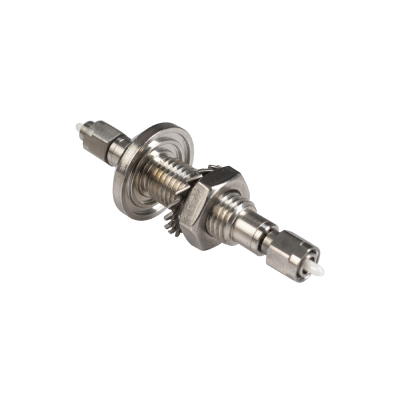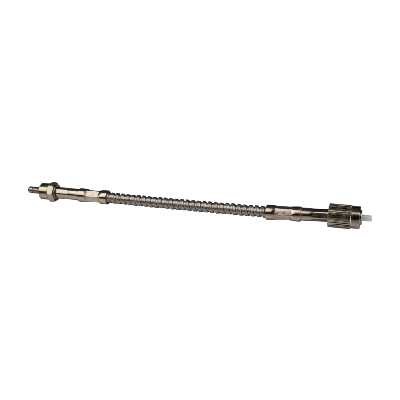OptoPyrolines
Fiber optic component for opto-pyrolines testing
SEDI-ATI offers spatialized multimode wavelength division multiplexers to control the integrity of the opto-pyrolines used in launchers and satellites.
Majorconstraints
The solution must withstand:
- Extreme temperatures from -125°C to +150°C, with sudden changes in the temperature (>10 °C per minute),
- Humidity ranges,
- Corrosive atmospheres,
- Acceleration force,
- Vibration levels,
- Launch loads,
- Altitude,
- Radiation,
- Vacuum.
Thechallenge
Verify the integrity of the opto-pyrolines on board space launchers and satellites, before activating specific spacecraft functionalities such as the ignition of boosters or the stand and payload separation.
What is the purpose of opto-pyrotechnics in launchers and satellites?
Opto-pyrotechnic systems are in widespread use in both launchers and satellites. Intense laser pulses are distributed via optical fibers to activate specific events through controlled explosions.
Among the operations triggered by ignition wavelength are the ignition of engines, of boosters and of distancing rockets. Opto-pyrotechnics are also used for stage and payload separation, valve opening, passivation and, if required, neutralization of the launcher. Some launchers can include several hundreds of meters of opto-pyrolines and several tens of pyro-functions.
What are the benefits of opto-pyrotechnics?
Opto-Pyrotechnics, i.e., initiation by laser pulses, has several advantages:
- no primary explosives are required (use of comparably insensitive secondary explosives increases safety),
- the devices are light and compact,
- the devices provide near-instantaneous response,
- reduced total mass,
- possible new functionality (built-in system test/verification),
- low current requirements,
- potential for better safety (immunity to EMI and ESD).
Although the system has been proven to be both reliable and safe, it is difficult to verify the integrity of the opto-pyrolines.
A customizable WDM
Thanks to our in-house capability to do thin-film deposition, we can design any application specific dichroic filters. Our customizable WDM can for instance check the integrity of the line with a very low energy monitoring wavelength, and allow a high-power laser ignition wavelength.
When the WDM returns an unusual attenuation of the interrogating wavelength scattered back to the monitoring line, it reveals that there is a default on the opto-pyrotechnic line. Indeed, the resultant light signature is analyzed by an OTDR (optical time-domain reflectometer) that provides detailed information on the location and overall condition of splices, connections, defects and other features of interest.
When it is proven that there is a failure on the transmission line, the opto-pyrotechnic device prevents the ignition wavelength from being fired. On the contrary, when the monitoring scattered light signature is “normal”, the ignition laser is allowed to activate the opto-pyro initiator [IOP] (or opto-pyro detonator [DOP]) that will trigger the booster separation or motor ignition for instance.
World first: boosters fired by a fiber-optic based opto-pyrotechnic system
SEDI-ATI is heavily involved in the program which consists in monitoring the integrity of the optopyro lines used to trigger the ignition of the P120C engine. The P120C will serve as a lateral booster for the Ariane 6 launchers and will equip the first stage of Vega-C.
On October 7, 2020, at Europe’s Spaceport in French Guiana, the successful final opto-pyrotechnic ignition test of the P120C solid rocket motor, took place. The maiden flight is scheduled for 2022/2023.
SEDI-ATI Fiber Optics is very proud to have contributed to the success of this world first!
Our solution
In order to detect in a safe way a default on the opto-pyrotechnic train line, such as a failure transmission or a weak connection, SEDI-ATI has developed a customizable multimode wavelength division multiplexer [WDM] with specific properties to address this type of application.
The materials are selected with care: very low outgassing, lightweight, space qualified…
Therefore, this ruggedized WDM performs its required security-check function under operational conditions of temperature, altitude, vacuum, radiation… Also, its performances of are not affected by acceleration forces, nor by shocks and vibration levels encountered during handling, transportation and launch operations.
SEDI-ATIsolution
We propose an interrogation component consisting of a spatialized fiber optic multimode wavelength division multiplexer [WDM], with a specific dichroic filter on the line port, to control the integrity of the opto-pyroline.
Advantagesof the SEDI-ATI solution
- Ruggedized WDM with a custom dichroic filter directly deposited onto the line port optical fiber,
- Thin-film deposition in-house,
- Very low outgassing and lightweight materials,
- Space-qualified optical fibers with an epoxy acrylate coating to withstand high temperatures.
Related products
Avionic fiber optic cables
SEDI-ATI has designed rugged avionic fiber-optic cables that meet the aeronautic constraints. Indeed, in aircraft, there are space and weight restrictions.
Cryogeny fiber optic cables
You are looking for a fiber optic link working at extremely cold temperatures? SEDI-ATI can provide specific cryogeny fiber optic cables.
M10-thread fiber-optic feedthrough for vacuum and pressure up to 600 bar
The KTRAV-M10 reconfigurable hermetic fiber-optic feedthroughs are suitable for vacuum and pressure applications up to 600 bars. They ensure a high level of hermeticity better than 10-10 mbar.l/s.
M12-thread fiber-optic feedthrough for vacuum and pressure up to 1000 bars
The KTRAV-M12 hermetic fiber-optic feedthroughs are suitable for vacuum and pressure applications up to 1000 bars. They ensure a high level of hermeticity better than 10-9 mbar.l/s.
Radiation-resistant fiber optic cables
Optical fibers gather numerous advantages encouraging to integrate them in applications with radiative environments, associated with the civil, space or defense fields.







